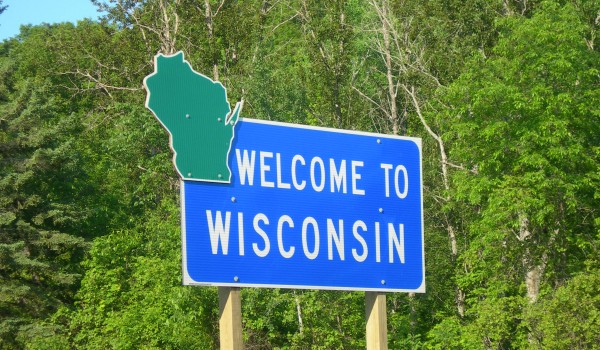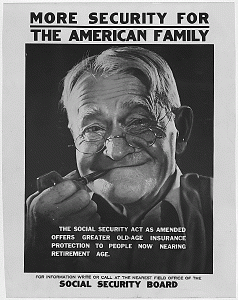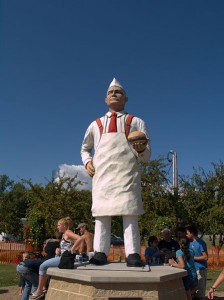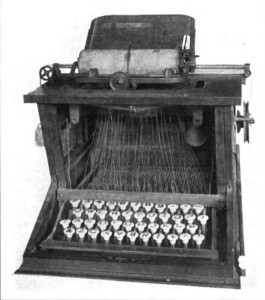
When you say Wisconsin, do you say supercomputers and kindergarten? What about headphones, bone marrow, transplants and the hamburger? Wisconsin is more than America’s Dairyland. It’s the place we found solutions for everything from the smoothie to Social Security.
THE BLENDER
The blender has given us confectionary goodness like milkshakes, daiquiris, homemade frosting, smoothies and margaritas. It’s underrated as a kitchen appliance and deserves  a round of applause.
a round of applause.
Racine native Stephen J. Poplawski invented the first blender in 1922, which became the Osterizer. His product was sold in drugstores and used for malted milkshakes for many years in Wisconsin.
Another Racine inventor, Frederick Osius, founder of the Hamilton Beach Manufacturing Company, worked on his own model of the blender. Osius talked his way into Fred Waring’s dressing room in 1933 after a live radio broadcast at the Vanderbilt Theatre in New York and convinced Waring to fund his research for the product. Waring fell in love with the technology and eventually bought Osius’s patent, giving birth to the Waring Blender that swept the country.
SOCIAL SECURITY
In the depths of the Great Depression, President Roosevelt turned to Wisconsin for a solution to crushing poverty among the nation’s elderly citizens. He placed UW-Madison economist and professor Edwin Witte at the helm of this project. Witte was already known as a champion of the “Wisconsin Idea,” the notion that the work of the university  should benefit the people of the state and the nation.
should benefit the people of the state and the nation.
That idea helped Witte forge the basis of the Social Security Act, which passed in 1935, and significantly impacted the economy. In the first three years of the act’s existence, it gave more than 25.5 million workers unemployment compensation and 1.7 million older Americans monthly cash allowances.
“The most important aspect of Social Security is that it created, for a great mass of older Americans, an economic foundation that they could rely on,” says historian Richard Pifer. “The average person, if all they have is Social Security, it’s not an easy existence, it’s not a lot of money. But, it provides an economic foundation that is pretty much universal across the country, that combined with Medicare, which is the medical system for the elderly, really guarantees a much healthier, enriched old age than what would have been true before.”
Social Security also created an “economic cushion,” according to Pifer, providing purchasing power that helped to smooth out economic downturns and prevented them from getting worse.
FIRST KINDERGARTEN IN AMERICA
Margarethe Meyer Schurz from Watertown founded the first kindergarten in America, according to Watertown’s Historical Society. Originally from Hamburg, Germany, she learned about the principles of kindergarten from Freidrich Froebel, who formed the first kindergarten in the world. After moving to America with her husband Carl Schurz, she started a small kindergarten in her home, but soon moved the kindergarten to a small building because her husband complained about the loud noise of having children in his home. Moving to this small building also accommodated for increasing class sizes.
To some, kindergarten might just look like naps, making fun shapes out of Play-Doh and singing rhymes, but studies have shown that a full day of kindergarten is an important step between preschool and first grade. It increases reading and mathematic comprehension and benefits children socially and emotionally.
Kindergarten also teaches skills such as self-regulation, responsibility, independence and cooperation, standard ingredients for the average grown-up, minus deadlines and naptime, of course.
KOSS STEREO HEADPHONES
John C. Koss has allowed us to get our jam on without being judged since 1958. Native to Milwaukee, Koss paved the way for individual listening technology with the world’s first  stereo headphones.
stereo headphones.
Originally meant to be a gimmick for his portable phonograph demonstration, his headphones created huge buzz and were a turning point for the audio industry. Up until that point, headphones were never used for music listening, only for communication.
Now everyone can privately listen to guilty pleasure music without worry. Just keep the 90s dance moves to a minimum.
THE SUPERCOMPUTER
Although the supercomputer got its origins elsewhere, Wisconsin’s very own Seymour Cray took the technology to new heights in 1976 when he created the fastest operating supercomputer of that time.

“He was the guy who really accelerated the pace at which supercomputers became mainstream,” Dan Negrut, an associate professor in the UW-Madison Department of Mechanical Engineering, says. “I think his main contribution was to recognize the fact that in supercomputers, what you need to have is a nice balance between the number crunching, the speed of processor and the memory speed.”
Cray transformed the supercomputer into a tightly integrated machine. According to Negrut, Cray recognized the importance of data storage and memory speed, not solely the number crunching those before him focused on. Cray created a general-purpose supercomputer that many fields were able to use.
The tight integration of Cray’s machine enhanced an already incredible technology. Essentially, supercomputers solve extremely large problems that cannot be performed on regular computers. Using a mathematical model, the supercomputer can virtually create an existing problem so scientists and mathematicians can find a faster solution.
Imagine all the things we take for granted: sturdy bridges, weather predictions so we can dress properly for the day or avoid a nasty storm. The supercomputer helps us find quick solutions for things like a failing bridge or even virtual detonation of bombs. With a working model, the supercomputer’s possibilities are endless.
TURBOTAP
It all started one summer in 1995 when Green Bay native Matt Younkle was waiting in line at the UW-Madison Memorial Union Terrace for a beer.
“Everyone was ordering pitchers because the line was so long and you didn’t want to have to just order a cup then get back in line right away again,” Younkle says. “So, I’m like, ‘Why is this line moving so slowly?’”
Waiting in a long line for beer seems like agony for many, but for Younkle, it turned into a blessing. As he waited, he tried to figure out why the line moved so slowly. He realized that pouring a pitcher of beer took 45 to 60 seconds. Imagine 50 people waiting in line and almost an hour will go by on pouring pitchers alone. Was there something that could be done better? Faster? More efficiently?
As a young entrepreneur, Younkle wanted a solution. Fast-forward to 2004 and the TurboTap came to life. The TurboTap, which pours beer faster and decreases the amount of foam on top, has benefitted sports arenas and stadiums all over the country. The TurboTap not only pours beer at a faster rate and delivers a pour with the perfect amount of foam, it also reduces spillage, which improves keg yields by 10 to 15 percent on average.
A tap that pours beer faster with ideal foam, you say? Louis Armstrong sure knew what he was saying when he sang “What a Wonderful World.”
HAMBURGER
 Whether you love double bacon cheeseburgers, a classic hamburger or a non-traditional sticky burger made with peanut butter, bacon and cheese, all burgers started somewhere regardless of how they are topped. While many claimed to be the chef extraordinaire who brought the original burger to life, Seymour residents believe their very own “Hamburger Charlie” is the true visionary.
Whether you love double bacon cheeseburgers, a classic hamburger or a non-traditional sticky burger made with peanut butter, bacon and cheese, all burgers started somewhere regardless of how they are topped. While many claimed to be the chef extraordinaire who brought the original burger to life, Seymour residents believe their very own “Hamburger Charlie” is the true visionary.
Charlie Nagreen, born in Hortonville, sold meat patties during the very first annual Seymour Fair in 1885. It was at that fair Charlie decided to put his meat patties in between two buns to make them easier to eat and more portable, according to Seymour’s Home of the Hamburger website. Alas, the first hamburger.
TYPEWRITER
The great-grandfather of today’s modern computer keyboard and cellphone texting, the typewriter, was invented by Christopher Latham Sholes and introduced for mass production in 1874.
Sholes was originally born in Pennsylvania, but came to Wisconsin around age 18. Here in Wisconsin, he invented the first typewriter. The invention sparked another technological advance; The “QWERTY” keyboard. Sholes found that many letters used next to each other in words caused the original typewriter keys to jam. He fixed this problem with a new key layout that remains on computer keyboards and cell phones today.
Although Sholes’ introduction of the typewriter went largely unnoticed, the technology generated huge impact over time. In the 1880s, the technology helped open new jobs for women in offices and created a new, cleaner and higher-paying job field. This innovation eventually led to the home computer, laptop and cellphone keyboards that most of us can’t exist without today.
BONE MARROW TRANSPLANT
The first bone marrow transplant did not happen in Wisconsin, but Wisconsin native, Dr. Fritz Bach, paved the way for more widely available, successful transplants.
Bone marrow transplants were tricky. Doctors struggled to find a compatible donor whose marrow would not be rejected in the transplant patient and therefore many transplants were unsuccessful. Dr. Bach created the mixed leukocyte culture technique to determine the compatibility of a bone marrow donor.
The technique takes cells from a donor and mixes them with the patient’s cells in a test tube. The reaction in the test tube is very similar to the reaction the cells would have inside the body, allowing doctors to choose a suitable donor from the patient’s family or other matches prior to transplantation. Dr. Bach’s technique increased the availability of transplants and success rates for bone marrow transplantation.
Dr. Bach’s technique was used for the first time in 1968; first to save the life of a 5-month-old boy born with a bone marrow defect and secondly on a 2-year-old boy suffering from constant bleeding and infections.




